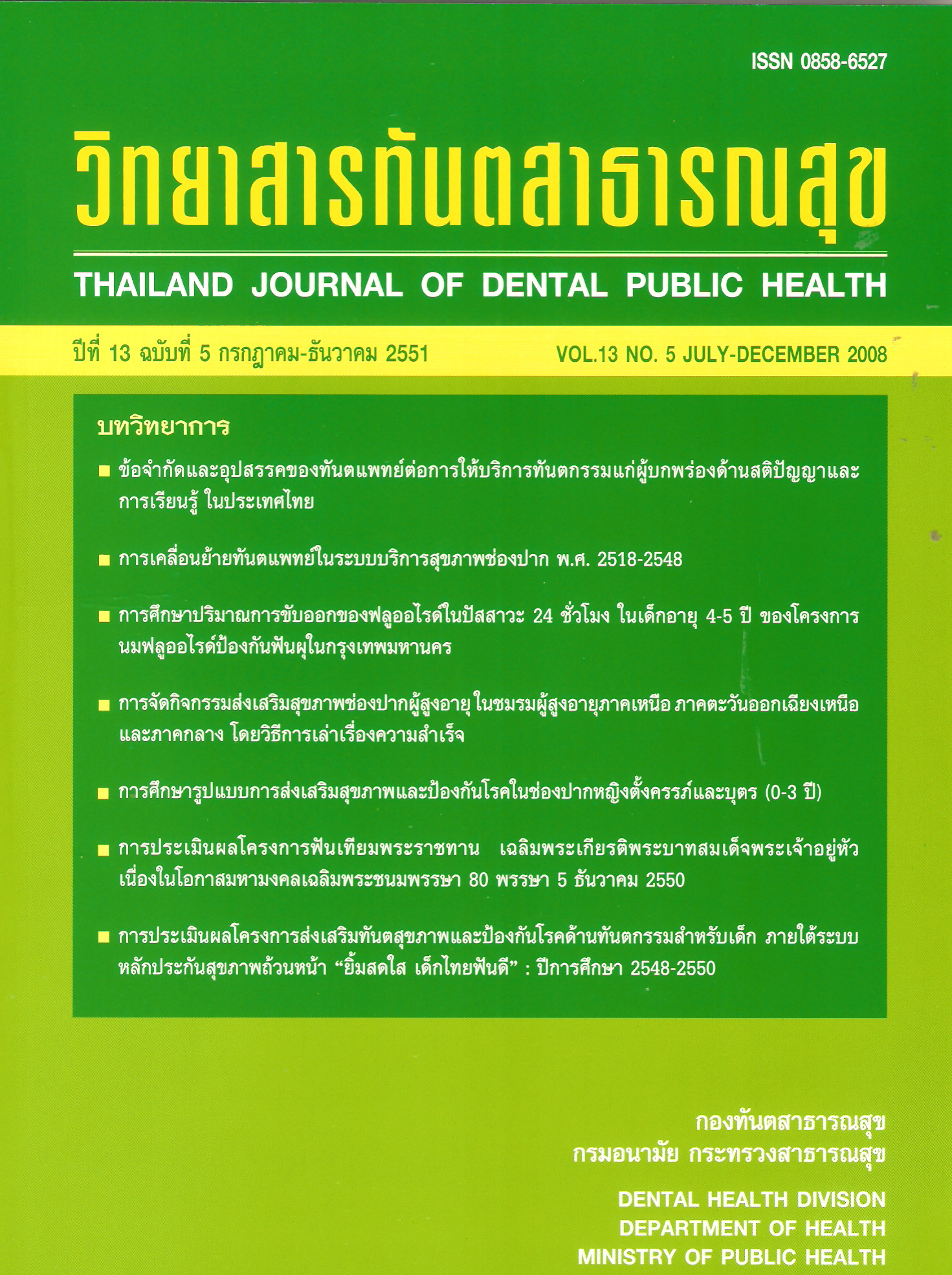Evaluation of 24 hours urinary fluoride excretion of children aged 4-5 years participating in the milk fluoridation programme, Bangkok
Main Article Content
Abstract
The aim of this study was to compare the 24-h urinary fluoride excretion rates of 4-5 year old school children participating in the milk fluoridation programme in Bangkok (n=30) with a control group (children of the same age, not exposed to F-milk) in Samut Prakarn province (n=29). The concentration of fluoride in the water in both districts is approximately 0.1 - 0.2 ppm. and investigations showed that the use of fluoridated toothpaste by both groups was similar. Each child's urine was collected over 24- h. Supervised collection of the urine samples was made during the school day by the research team and separated into two periods( those taken before the consumption of fluoridated milk and those taken after). In the third period, the intervening hours at home, samples were collected by the parents of the participating children. The urinary volume and urinary flow for each of the three periods were determined. Urinary fluoride concentration and urinary fluoride excretion rate per hour were also calculated. The average 24-h urinary fluoride excretion was higher in the group consuming fluoridated milk than in the control group: 346.91 ( 89.93) and 207.69 ( 106.08) _g respectively. The average 24-h urinary fluoride concentrations were 0.63 (_ 0.23) and 0.35 ( 0.12) ppm. in the group consuming fluoridated milk and the control group respectively. With reference to the provisional standards for urinary fluoride excretion and concentrations (WHO) both the average total 24-h urinary fluoride excretion and the urinary fluoride concentration of the children consuming fluoridated milk were shown to be within acceptable limits. In conclusion the study demonstrates that the children participating in the milk fluoridation programme in Bangkok do not appear to have an increased risk of dental fluorosis.
Downloads
Article Details
References
2. Petersen PE. The World Oral Health Report 2003: Continuous improvement of oral health in the 21st century the approach of the WHO Global Oral Health Programme. Community Dentistry and Oral Epidemiology 2003:31(Suppl.1):3-24.
3. Lennon MA et al., Legislation and community based aspects of the implementation of a milk fluoridation programme. In: Stephen K, Banoczy Jand Pakhomov GN, eds: Milk fluoridation for the prevention of dental caries. World Health Organization/Borrow Dental milk Foundation, Geneva. 1996.
4. World Health Organization Ed: Marthaler, Monitoring of renal fluoride excretion in community preventive programmes on oral health. Geneva, 1999.
5. Szekely M et al., Comparative baseline study of the urinary fluoride excretion in Romanian pre-school children. Caries Research. 2004: 38: 337, Abstract 58.
6. Villa A, Anabalon, M and Cbezas, L, The fractional urinary fluoride excretion in young children under stable fluoride intake condition. Community Dentistry and Oral Epidemiology. 2000: 28: 344-355.
7. Villa A, Critical evaluation of previously published data on the fractional urinary fluoride excretion in young children. Community Dental Health. 2004: 21: 155-169.
8. Baez R, Baez M and Marthaler TM, Urinary fluoride excretion by children 4-6 years old in a South Texas community, Pan Am J Public Health. 2000:7:242-248.
9. Rugg-Gunn AJ et al., Urinary fluoride children in 4-year-old children in Sri Lanka and England. Caries Res. 1993: 27:478-483.
10. Rugg-Gunn AJ, Al-Mohammadi SM and Butler TJ, Malnutrition and developmental defects of enamel in 2 to 6 year-old Saudi boys. Caries Res. 1998: 32:181-192.
11. Zohouri FV and Rugg-Gunn AJ, Total fluoride intake and urinary excretion in 4-year-old Iranian children residing in low fluoride areas, British journal of Nutrition 2000: 83: 15-25
12. Katley CE et al., Urinary fluoride excretion of young children exposed to different fluoride regimens. Community Dental Health. 2002: 19:12-17.
13. Marthaler TM et al., Urinary fluoride excretion in pre-school children related to the use of fluoridated milk or salt. Caries Res. 1994: 28:217.
14. Marthaler TM et al., Urinary fluoride excretion in children with low fluoride intake or consuming fluoridated salt. Caries Res. 1995: 29:26-34.


